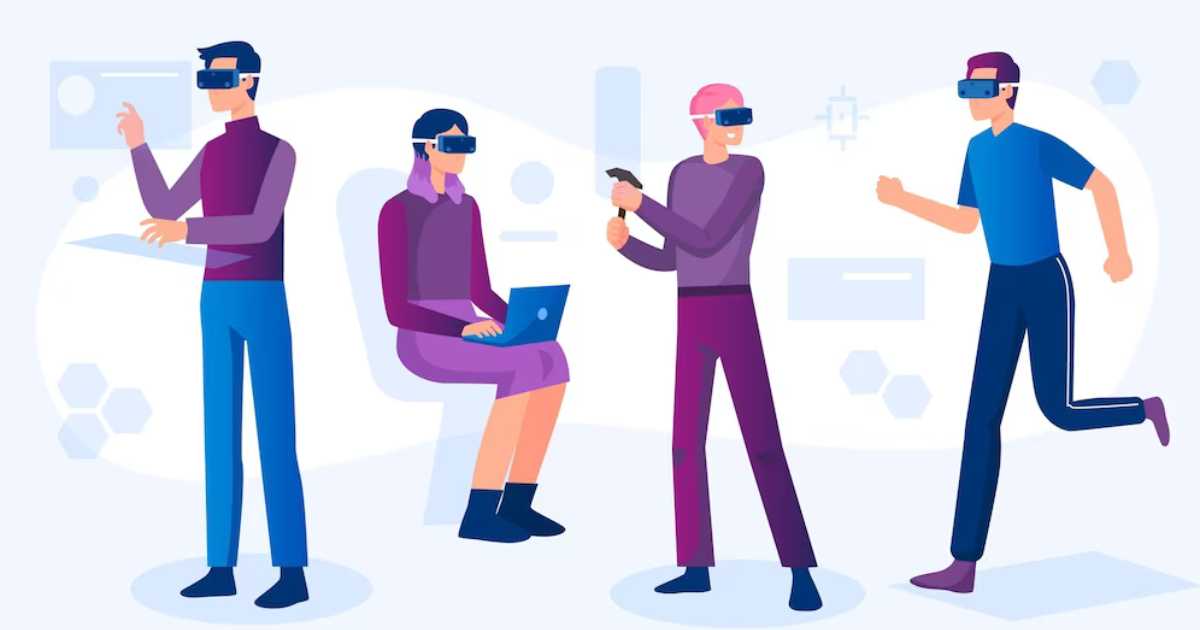In the fast-paced digital age, where attention spans are dwindling and competition is fierce, businesses are constantly seeking innovative ways to captivate their target audience and create lasting impressions. (VR) Virtual reality marketing has emerged as a powerful tool that allows brands to break through the noise and engage customers in immersive Experiences. By leveraging the latest VR Technology, businesses can transport their audience into a virtual world, leaving a lasting impact and Driving customer engagement like never before.
Introduction
In this post, we’re going to look into the interesting realm of VR marketing and see how it might improve User experience in the modern era. We will go into the idea of VR marketing, its advantages, and the different strategies companies can use to provide customers with Experiences they won’t soon forget. So let’s get started!
The Power of Virtual Reality Marketing
In today’s fast-paced and technologically advanced world, businesses are constantly seeking innovative ways to capture the attention of their target audience. One such groundbreaking technology that has taken the marketing industry by storm is virtual reality (VR). In this article, we delve into the realm of virtual reality marketing and explore its immense potential to transform the way brands engage with their customers.
#What is Virtual Reality Marketing?
Virtual reality marketing refers to the strategic use of virtual reality technology to create immersive and interactive experiences that promote products, services, or brand messages. By leveraging VR, businesses can transport consumers into a simulated environment that allows for a heightened level of engagement and emotional connection.
“Sign up for the Best Virtual Reality Services and Get Free Access!”
10 Mind-Blowing Ways VR Marketing Takes Customer Engagement to the Next Level
- Step into the Future: Virtual Reality Brings Products to Life in a Whole New Dimension!
- Get Ready to Be Amazed: VR Lets Customers Experience Your Brand Like Never Before.
- Say Goodbye to Boring Ads: Virtual Reality Marketing Creates Immersive and Memorable Experiences.
- Feel the Thrill: VR Engages Customers with Exciting Interactive Simulations.
- Break the Distance Barrier: VR Transports Customers to Remote Locations Without Leaving Home.
- Be the Star: Virtual Reality Lets Customers Become the Hero of Your Brand’s Story.
- Unlock Their Senses: VR Appeals to Multiple Senses for a Truly Immersive Encounter.
- Personalize the Experience: VR Allows Customers to Tailor Their Engagement with Your Brand.
- Bye-Bye Window Shopping: VR Enables Customers to Virtually Try Before They Buy.
- Stay Ahead of the Curve: Embrace VR Marketing to Leave Your Competitors in the Dust!
#Understanding Virtual Reality Marketing
Virtual reality is a computer-generated simulation that immerses users in a three-dimensional, interactive environment. VR technology typically involves wearing a headset that tracks the user’s head movements and displays visuals in real-time, creating a sense of presence and immersion. In the realm of marketing, VR provides a unique opportunity to engage customers on a deeper level by transporting them to virtual worlds that evoke emotions and capture their attention.
#The Benefits of Virtual Reality Marketing
- Unparalleled Immersion: Virtual reality provides a level of immersion that traditional marketing channels simply cannot match. By wearing a VR headset, users are transported into a virtual world where they can explore, interact, and experience a brand in a way that feels remarkably real. This level of immersion enhances brand recall and leaves a lasting impression on the audience.
- Emotional Impact: VR experiences have the unique ability to evoke powerful emotions in users. By tapping into the emotional aspects of marketing, businesses can forge deep connections with their audience, resulting in increased brand affinity and loyalty. Whether it’s through a thrilling adventure or a heartwarming storytelling experience, virtual reality marketing has the potential to elicit strong emotional responses.
- Enhanced Engagement: Traditional marketing methods often struggle to capture and maintain consumer attention. However, VR marketing captures attention effortlessly by offering a captivating and interactive experience. Users actively engage with the content, resulting in prolonged exposure to the brand’s message and a higher likelihood of conversion.
- Memorable Brand Experiences: VR allows businesses to create unforgettable brand experiences that stand out from the competition. Whether it’s showcasing a product demonstration, offering virtual tours, or hosting virtual events, brands can leave a lasting impact on their audience, leading to increased brand recognition and positive word-of-mouth.
#Enhancing Customer Engagement with Virtual Reality
1. Immersive Storytelling and Brand Experiences
One of the key strengths of VR marketing is its ability to transport customers into unique and immersive brand experiences. By creating virtual environments that align with their brand identity, businesses can tell captivating stories and connect with customers on a deeper level. For example, a travel agency can use VR to allow customers to virtually explore popular destinations, igniting their wanderlust and inspiring them to book their next vacation.
2. Interactive Product Demonstrations
VR technology enables realistic and interactive product demonstrations, revolutionizing the way businesses showcase their offerings. Customers can now try out products virtually, experiencing their functionality and benefits firsthand. For instance, an automotive company can offer virtual test drives, giving potential buyers a realistic feel of the vehicle’s performance and features.
3. Virtual Tours and Experiential Marketing
VR also opens up new possibilities for businesses in industries such as real estate, hospitality, and tourism. Customers can take virtual tours of properties or Destinations, giving them a sense of what it would be like to be physically present. This immersive experience helps Customers make informed decisions and fosters a sense of trust and transparency.
#Creating Memorable Experiences with VR Marketing
To maximize the impact of VR marketing, Businesses should focus on creating memorable experiences that resonate with customers. Here are some key strategies:
1. Personalization and Customization
By tailoring virtual experiences to individual preferences, businesses can create a sense of personalization. Customizable avatars, personalized narratives, and adaptive environments make customers feel more connected and invested in the experience.
2. Emotional Connection with the Audience
VR has the power to evoke strong emotions and forge deep connections. Businesses should leverage this by Designing experiences that tap into customers’ Emotions, creating memorable moments that leave a lasting impression. For example, a charity organization can use VR to transport users to a remote location, allowing them to witness the impact of their donations firsthand.
3. Gamification and Interactive Elements
Introducing game-like elements and interactive challenges within VR experiences can enhance engagement and increase enjoyment. Businesses can incorporate leaderboards, rewards, and interactive puzzles to keep customers actively involved and motivated to explore further.
#Overcoming Challenges in VR Marketing
While the potential of VR marketing is immense, there are challenges that businesses need to address:
- Cost Considerations: Implementing VR marketing strategies can involve significant costs, including VR headset investments, software development, and content creation. However, as the technology evolves, costs are gradually decreasing, making it more accessible to businesses of all sizes.
- Accessibility and Device Limitations: Not all customers may have access to VR devices or be comfortable using them. Businesses should consider providing alternative options for customers who cannot experience VR, ensuring inclusivity in their marketing campaigns.
- User Experience and Technical Issues: Ensuring a seamless user experience is crucial in VR marketing. Technical glitches, motion sicknesses, or latency issues can detract from the overall experience. Thorough testing and continuous improvements are necessary to deliver optimal performance.
#Implementing VR Marketing Strategies
To effectively implement VR marketing, businesses should consider the following steps:
- Set Clear Goals and Objectives: Define specific goals and objectives for your VR marketing campaigns. Whether it’s increasing brand awareness, driving sales, or enhancing customer engagement, clarity of purpose is essential for success.
- Target the Right Audience: Identify your target audience and tailor your VR experiences to their preferences and interests. Conduct market research to understand their needs, desires, and pain points, and design VR campaigns that address those effectively.
- Integrate VR with Other Marketing Channels: VR marketing should complement and integrate with your overall marketing strategy. Combine VR experiences with social media, email marketing, and other channels to create a cohesive and consistent brand presence.
#Virtual Reality Marketing Applications
Virtual reality marketing has a wide range of applications across various industries. Let’s explore some of the most compelling use cases:
- Real Estate:
Virtual reality has revolutionized the real estate industry by enabling immersive property tours. Potential buyers can virtually explore properties from the comfort of their homes, visualizing spaces in great detail and getting a realistic sense of the property’s layout and ambiance. This immersive experience streamlines the decision-making process and enhances customer satisfaction. - Travel and Hospitality:
VR allows travel and hospitality brands to transport potential customers to their dream destinations. Users can virtually experience hotel rooms, resorts, or even popular tourist attractions, providing a glimpse into what awaits them. By showcasing breathtaking locations and immersive experiences, businesses in this industry can entice travelers and generate excitement, ultimately driving bookings and customer loyalty. - Automotive:
The automotive industry has embraced virtual reality to revolutionize the car buying experience. VR showrooms enable potential buyers to explore various car models, customize features, and even take virtual test drives. This immersive approach enhances the customer’s understanding of the vehicle’s features and allows for a more personalized and engaging car shopping experience. - Education and Training:
Virtual reality has significant potential in the field of education and training. It offers a realistic and interactive environment for learners to practice skills, simulate real-life scenarios, and explore complex concepts. From medical simulations to employee training programs, VR can enhance learning outcomes and make educational experiences more engaging and memorable.
#Success Stories of VR Marketing
Several brands have successfully leveraged VR marketing to engage customers and achieve remarkable results. Some notable examples include:
IKEA: The furniture retailer introduced an augmented reality (AR) app that allows customers to virtually place furniture in their homes before making a purchase. This innovative use of AR technology has significantly improved customer confidence and reduced returns.
Marriott Hotels: Marriott created “VRoom Service,” a VR experience that offers guests virtual tours of exotic destinations, giving them a taste of what their next vacation could look like. This immersive experience has resulted in increased bookings and customer satisfaction.
The Future of Virtual Reality Marketing
As technology continues to advance, the future of virtual reality marketing appears promising. Here are some trends and developments to watch out for:
- Social VR: Virtual reality has the potential to transform the way people connect and interact. Social VR platforms allow users to meet, socialize, and collaborate in virtual environments, providing brands with opportunities to create shared experiences and build communities around their products or services.
- E-commerce Integration: VR is set to revolutionize online shopping by bridging the gap between brick-and-mortar and e-commerce experiences. With the integration of virtual reality, customers can virtually try on products, visualize how furniture looks in their homes, or even attend virtual fashion shows, enhancing the overall online shopping experience.
- Cross-Industry Adoption: As more businesses recognize the value of virtual reality marketing, we can expect to see its widespread adoption across industries. From healthcare and tourism to retail and entertainment, VR will become an integral part of marketing strategies, offering unique and compelling experiences to customers.
Conclusion
Virtual reality marketing has emerged as a powerful tool that enables brands to captivate their audience, create memorable experiences, and forge deep connections. With its unparalleled immersion, emotional impact, and enhanced engagement, VR has the potential to revolutionize the way businesses communicate with their customers. By embracing virtual reality marketing, brands can stay ahead of the competition and create meaningful interactions that leave a lasting impression.
FAQs:
Q: What is virtual reality marketing?
A: Virtual reality marketing is a strategy that utilizes VR technology to create immersive and interactive experiences that Engage customers and Leave a lasting impact.
Q: How does VR marketing enhance customer engagement?
A: VR marketing enhances customer engagement by transporting them into virtual environments, allowing for immersive storytelling, interactive product demonstrations, and virtual tours that create memorable experiences.
Q: What are the challenges of implementing VR marketing?
A: Challenges of implementing VR marketing include cost considerations, accessibility and device limitations, and ensuring a seamless user experience free from technical issues.
Q: How can businesses measure the success of their VR marketing campaigns?
A: Success in VR marketing can be measured through metrics such as increased brand awareness, customer engagement levels, sales conversions, and customer satisfaction.
Q: What are the future trends in VR marketing?
A: Future trends in VR marketing include advancements in VR technology, more realistic and immersive experiences, and the exploration of new applications in various industries.
Also, Read- 5 Ways Influencer Marketing For Startups: Reach Your Target Audience with Power!






